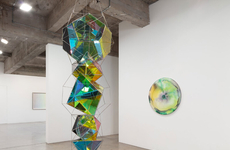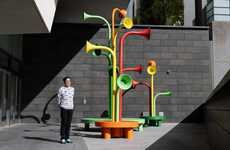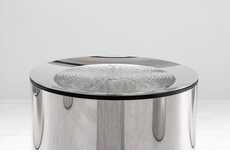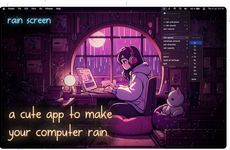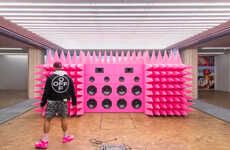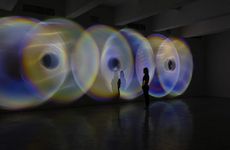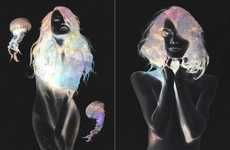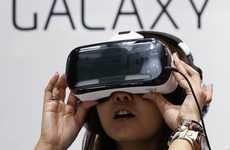
The Re-Rain Exhibit Creatively Uses Sound to Simulate a Rain Storm
M — February 6, 2016 — Art & Design
References: kyouei-ltd.co.jp & thecreatorsproject.vice
The Re-Rain exhibit by Kouichi Okamoto that creatively replicates a rain storm without the use of water. The installation cleverly relies on sound and visualization to invite viewers to experience a simulated rainfall that is fully immersive -- without getting wet. This is done using reverse sound and the way the vibrations hit objects to create the audio of rain falling from the sky.
Okamoto piece is designed with 15 dark blue umbrellas that are linked to a speaker that plays sounds of rain falling. The vibrations of the recorded sounds are engineered to bounce off of the umbrellas and creating sound waves that replicate both the sensation of rain falling as well as the acoustics of the natural phenomenon.
The Re-Rain show is available for visit at the Shizuoka Prefectural Museum of Art in Japan.
Okamoto piece is designed with 15 dark blue umbrellas that are linked to a speaker that plays sounds of rain falling. The vibrations of the recorded sounds are engineered to bounce off of the umbrellas and creating sound waves that replicate both the sensation of rain falling as well as the acoustics of the natural phenomenon.
The Re-Rain show is available for visit at the Shizuoka Prefectural Museum of Art in Japan.
Trend Themes
1. Sensory Rainfall Installations - Sensory installations that simulate rainfall using sound and visualization without actual water can disrupt the tourism industry by attracting visitors seeking immersive and unique experiences.
2. Reverse Sound Technology - The use of reverse sound technology for sensory experiences can revolutionize the entertainment industry by creating engaging and immersive environments for audiences.
3. Immersive Soundscapes - The creation of immersive soundscapes through innovative technology has the potential to transform the gaming industry by enhancing the virtual experience of games with realistic sound effects.
Industry Implications
1. Tourism - The tourism industry can benefit from investing in sensory installations that provide unique and immersive experiences for visitors, attracting more customers and increasing revenue.
2. Entertainment - The entertainment industry can leverage reverse sound technology to create immersive environments for audiences, enhancing the sensory experience and attracting more fans.
3. Gaming - The gaming industry can incorporate immersive soundscapes to enhance the virtual experience of games, creating more engaging and realistic gaming environments for players.
6.4
Score
Popularity
Activity
Freshness


